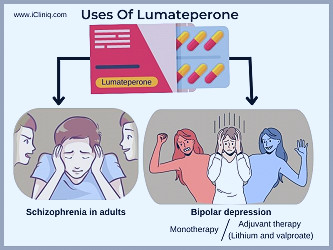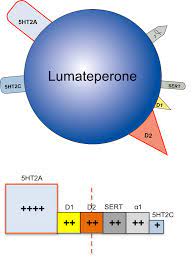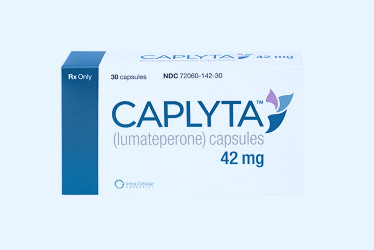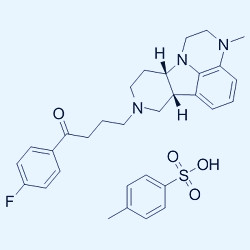
Exploring Lumateperone: A New Frontier in Schizophrenia Treatment
Lumateperone is an innovative pharmaceutical product designed to treat mental health disorders, such as schizophrenia. Marketed under the brand name Caplyta, it works by balancing the activity of certain natural substances in the brain to reduce hallucinations and improve concentration. Lumateperone offers a new approach to mental health treatment, with a focus on minimizing side effects and enhancing patient wellbeing.
Introduction to Lumateperone
Lumateperone is a novel antipsychotic drug developed by Intra-Cellular Therapies, Inc. It is an atypical antipsychotic medication primarily used for the treatment of schizophrenia. The drug operates by modulating the serotonin, dopamine, and glutamate neurotransmitter systems in the brain. Read more
Mechanism of Action
The mechanism of action of lumateperone is unique and innovative. It acts as a partial agonist at the 5-HT2A serotonin receptor and an antagonist at the dopamine D2 receptor. It also has an effect on the glutamatergic system, possibly helping with cognitive and negative symptoms of schizophrenia. Read more
FDA Approval and Indications
Lumateperone, marketed under the brand name Caplyta, received FDA approval in December 2019. It is indicated for the treatment of schizophrenia in adults and is being studied for the treatment of bipolar depression and other neuropsychiatric and neurologic disorders. Read more
Efficacy and Clinical Trials
Clinical trials have demonstrated the efficacy of lumateperone in reducing the severity of schizophrenia symptoms. These trials have utilized the Positive and Negative Syndrome Scale (PANSS) to evaluate symptom reduction, with lumateperone showing significant improvement over placebo. Read more

Side Effects and Safety Profile
Lumateperone has a favorable safety profile with fewer side effects than most antipsychotic medications. Common side effects include somnolence, dry mouth, and constipation. Importantly, it does not seem to cause significant weight gain, a serious side effect of many antipsychotic medications. Read more
Dosage and Administration
The recommended dose of lumateperone is 42 mg once daily, taken with food. Unlike some antipsychotic medications, there is no need for dose titration, simplifying the administration process. Read more
Interactions and Contraindications
Lumateperone can interact with other medications, particularly those that affect the CYP3A4 enzyme system. It is contraindicated in patients with known hypersensitivity to the drug. Read more
Future Prospects
Ongoing research is evaluating the use of lumateperone in the treatment of other conditions, such as bipolar depression, dementia-related psychosis, and Parkinson's disease psychosis. This may expand the therapeutic applications of this drug in the future. Read more

Cost and Accessibility
The cost of lumateperone can be a limiting factor for some patients. However, the manufacturer offers a patient assistance program to help reduce the financial burden. Read more
Expert Opinions
Health professionals have given positive reviews about lumateperone, praising its efficacy, tolerability, and novel mechanism of action. However, they also stress the importance of continued research to further understand its long-term effects and potential uses. Read more
Read more
 Lumateperone - Wikipedia
Lumateperone - Wikipedia Dosing Information - CAPLYTA® (lumateperone)
Dosing Information - CAPLYTA® (lumateperone) FDA Grants New Indication to Lumateperone for Bipolar Depression
FDA Grants New Indication to Lumateperone for Bipolar Depression Lumateperone | C24H28FN3O | CID 21302490 - PubChem
Lumateperone | C24H28FN3O | CID 21302490 - PubChem Lumateperone tosylate (ITI-007 tosylate) | 5-HT2A Receptor Antagonist | MedChemExpress
Lumateperone tosylate (ITI-007 tosylate) | 5-HT2A Receptor Antagonist | MedChemExpress Lumateperone Two New Dosages Approved: 21 mg & 10.5 mg – Psychiatry Education Forum
Lumateperone Two New Dosages Approved: 21 mg & 10.5 mg – Psychiatry Education Forum Lumateperone: Mechanism of Action? – Psychiatry Education Forum
Lumateperone: Mechanism of Action? – Psychiatry Education Forum Lumateperone
Lumateperone lumateperone Tosylate | C31H36FN3O4S | CID 44241743 - PubChem
lumateperone Tosylate | C31H36FN3O4S | CID 44241743 - PubChem This Month in Psychopharmacology
This Month in Psychopharmacology Caplyta Approved for Bipolar Depression in Adults - MPR
Caplyta Approved for Bipolar Depression in Adults - MPR![313368-91-1 | Lumateperone | 1-(4-fluorophenyl)-4-[(6bR,10aS)-3-methyl-2,3,6b,9,10,10a-hexahydro-11H-pyrido[3',4':4,5]pyrrolo[1,2,3-de]quinoxalin-8(7H)-yl]butan-1-one; ITI 007; 1-(4-Fluorophenyl)-4-[(6bR,10aS)-2,3,6b,9,10,10a-hexahydro-3-methyl-1H ...](/static/lumateperone/12.thumb.jpg) 313368-91-1 | Lumateperone | 1-(4-fluorophenyl)-4-[(6bR,10aS)-3-methyl-2,3,6b,9,10,10a-hexahydro-11H-pyrido[3',4':4,5]pyrrolo[1,2,3-de]quinoxalin-8(7H)-yl]butan-1-one; ITI 007; 1-(4-Fluorophenyl)-4-[(6bR,10aS)-2,3,6b,9,10,10a-hexahydro-3-methyl-1H ...
313368-91-1 | Lumateperone | 1-(4-fluorophenyl)-4-[(6bR,10aS)-3-methyl-2,3,6b,9,10,10a-hexahydro-11H-pyrido[3',4':4,5]pyrrolo[1,2,3-de]quinoxalin-8(7H)-yl]butan-1-one; ITI 007; 1-(4-Fluorophenyl)-4-[(6bR,10aS)-2,3,6b,9,10,10a-hexahydro-3-methyl-1H ... lumateperone
lumateperone Lumateperone Tosylate API Manufacturer and Supplier | CAS 313368-91-1 - Dr. Reddy's
Lumateperone Tosylate API Manufacturer and Supplier | CAS 313368-91-1 - Dr. Reddy's Lumateperone: Mechanism of Action - YouTube
Lumateperone: Mechanism of Action - YouTube The role of lumateperone in the treatment of schizophrenia - Alveena Batool Syed, James Robert Brašić, 2021
The role of lumateperone in the treatment of schizophrenia - Alveena Batool Syed, James Robert Brašić, 2021 Medchemexpress LLC HY-19733 5mg Medchemexpress, Lumateperone (tosylate) | Fisher Scientific
Medchemexpress LLC HY-19733 5mg Medchemexpress, Lumateperone (tosylate) | Fisher Scientific Frontiers | Atypical Antipsychotic Lumateperone Effects on the Adrenal Gland With Possible Beneficial Effect of Quercetin Co-administration
Frontiers | Atypical Antipsychotic Lumateperone Effects on the Adrenal Gland With Possible Beneficial Effect of Quercetin Co-administration Caplyta (Lumateperone) - PSYCH-MENTAL HEALTH HUB
Caplyta (Lumateperone) - PSYCH-MENTAL HEALTH HUB Lumateperone for schizophrenia | MDedge Psychiatry
Lumateperone for schizophrenia | MDedge Psychiatry 
